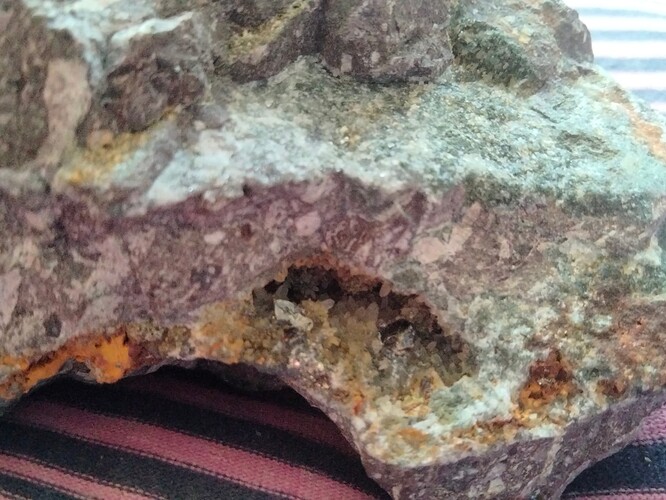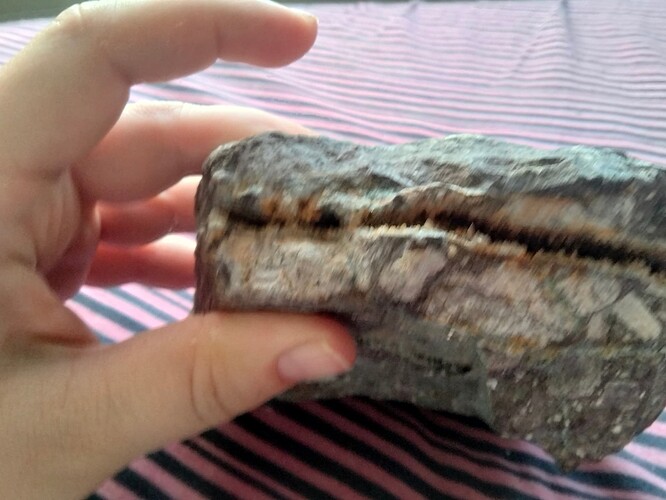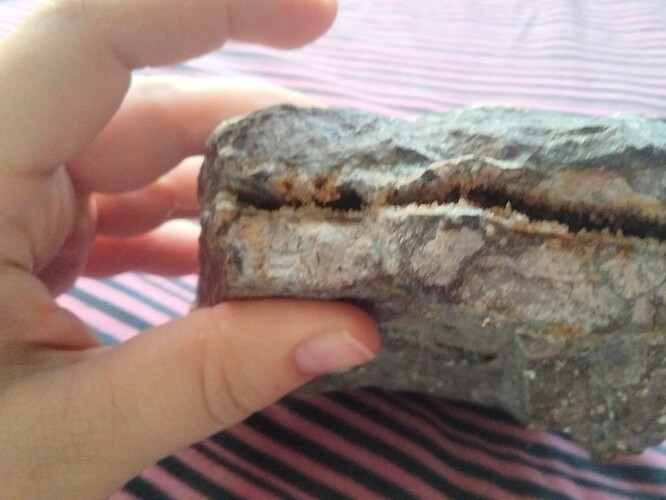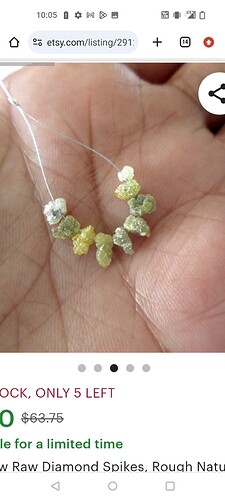I I have a rock with gems in-between it. It looks like orange spikes sandwiched in between the rock. doers anyone have onsite or opinion of what it may be. I got it about 5 years ago now from eBay. Thanks!
Possibly some kind of quartz
This may seem like a far fetched idea but I was googling diamond shapes. Does anyone think those spikes could be called that rare form of rough diamond spikes?
Could they be nanodiamonds? They are diamonds with spikes!
the parent rock looks like metaconglomerate in places and a granite in others… there’s also a blue colored layer above the crack containing crystals. Without knowing where it came from and what the geologic setting is, it’s not possible to definitely identify anything accurately. The fact that there is an open crack suggests that the crystals were deposited secondarily and not in association with the parent rock. those crystals could be far younger than the parent rock itself.
secondary mineralization would most likely cause quartz or calcite to form. the prIsmatic tapered ends lstrongly suggest quartz, particularlky if it’s in a crack… the blue layer is actually more interesting, if this is hydrothermal, it could be copper containing but again, it’s impossible to tell from photos, The rest of the rock is solid looking and does not appear to have been hydrothermally altered, Your best bet is to take it to your local univeristy geology department and see if a geologist there can identify your rock as a whole, as well as the crystals… you will need to tell them exactly where you found the specimen. Without knowing where it came from, it will be impossible to place the rock in it’s geologic setting.
Diamonds are definitely out… their formation involves pressures and temperatures deep within the earth where no open cracks can exist. transport to the surface involves explosive kimberlitic/ lamprohytic volcanism that results is a jumble of fragmented rocks containing other high pressure mineral phases icluding garnet and phologopite mica.
absolutely not diamonds!!!
Quartz
none of this rock is altered. when I got it it was a 25 pound rock and it had layers of hollowness rock inbetween the layers of the rock and I took a hammer at the layers and this is my favorite piece of the whole rock. I am the one who came accross the spikes the layers of the rock! except the top of the rock with the white and green on the top of the rock was the only part already showing their when I got the rock. so all the spikes were found by me! in the first picture of in second set of pictures is the picture of rock that was a very top layer of rock that I could psysically see when I got the rock in the mail. I am the one who unovered the rest of the gemstones inbetween the rock. I got this rock from ebay. the person I bought it from was from shipped from la jola colorado usa. I don’t know where that person specifically got it from. thank you for all the info!
what type of quartz is so small? Is their a special name for that kind of quartz? id love to google more and read about it! thanks
small fissure filling quartz crystals are called quartz druse…very common in vein deposits with open spaces. look and see if the prisms are hexagonal in shape… the tips will also be hexgonal… if they are, it’s quartz far more likely than not. if there’s no evidence of secondary alteration, it could be primary hydrothermal vein filling quartz. The greenish blue stuff could be a more interesting mineral assemblage if it is a vein filling. A google search of la jolla CO brought up La Junta and La Jara… La Junta is east of Pueblo CO on the plains, La Jara is in the San Luis Valley, next to the border of New Mexico. The San Luis Valley is the northern extent of the Rio Grande rift valley, a spreading zone. The Sangre de Christo range is to the east and the eastern extension of the San Juan mountains is to the west…If it were shipped by a dealer, you’d have to ask them where it came from, and what it was if they know. Otherwise your best bet is still to have it identified by a local geologist.
If you are a beginner rock hound, I suggest buying the Simon and Schuster Field Guide to Minerals and Rocks. You will find very useful information there. Join your local rockhound club… Borrow some books from your local library and take out a few on geology, the rock cycle, and mineralogy. Knowing gems is applied mineralogy. Mineralogy has to be taken in context of the geology. The host rock and geological setting is very important in identifying anything. I started out as a rock hound when I was a kid… read as much as I could. I found and picked up my share of pretty rocks that are hard to find… now I collect scientific papers on geochemistry and petrology… a plain old rock can tell you the history of the earth from the time it accreted in the solar nebula to the present…Isotope ratios, trace element profiles give you vast amounts of information… but it does require a lot of study. I do not have a formal degree in geology but have learned a lot on my own reading text books for geology 300 and 400 level. It requires some a lot of pre existing knowledge of chemistry and physics, which I have… advances in earth sciences are technologically driven and have gone exponential. I encourage you to read and learn as much as you can about rocks and minerals, starting with the basics… if you live in an area that is mountainous, you will be surrounded by rocks or all kinds…even if you live on the great plains, you still will be able to find mineral specimens on your own, but only if you know where to look… your local rock hound club will know.
The term for a surface covered with a layer of small crystals is “DRUSY”. Your specimen shows signs of hydrothermal alteration, which likely accounts for the yellowish color on the quartz… if the quartz has trace amounts of nickel in its atomic structure then the yellow color is throughout and the name for the quartz crystals becomes “citrine”, but that is very unlikely. There is a nice drusy quartz location filling veins just like yours at an abandonded mining area in the San Luis Valley…I have collected there many times. From the town of La Garita, Colo. go 2.2 miles North out of town, then take the dirt road NW up Bidell Creek for 6.5 miles and the mining area is on the right side of the road. It is large and you can’t miss it. Some of the best collecting of large drusy quarz veins with great hexagonal tipped crystal is in the large boulders along the road that have rolled down from the mine. Always much more interesting to find it yourself… rather than making an eBay purchase. Good luck to all of you who want to visit this nice locality.
La Garita is a giant caldera, there are many overlapping ones, including Creede caldera, in that area as part of the San Juan volcanic field that erupted 40 - 20 Ma ago… those eruptions were followed by hydrothermal activity that deposited quartz, and amythyst with silver at Creede. the rock is fractured allowing for hot water circulation that deposited minerals and ores. open fissure fillings were with ore minerals and quartz. Drusy quartz in abundant in the area, as fracture fillings in the welded ryolite tuffs. I posted about the San Luis valley and surrounding mountains to the next rock ID question that Jennifer posed about “white jade.”
You might be interested in that Valles Grande Caldera in New Mexico erupted twice, 1.2Ma ago and the last 600Ka ago. There is still hot rock under the surface but no magma. geothermal exploration years ago showed that along with geophysical measurements. Hot springs still are evidence of a hydrothermal cirulation but all meteoric water.now…with the exception of native sulfur…The last eruption created a hydrothermal system, similar to Creede which is much older, on the southeast flank of the caldera where amethyst is present along with silver. The land is patented. I did manage to collect an inch long pale amethyst crystal on the road before being accosted by a land owner, who was suspicious that I was trying to explore for silver,…Underground mining took place on a large scale in the late 1800’s before the silver was exhausted. The abandoned site is inaccessible and closed off, as it’s a danger… Like Creede, native silver was present as clumps of silver wire crystals…
The white rock I thought was jade and this post about the gems in-between the rock came from 2 different sellers. Actually the eyesofnepherite person on etsy was someone I bought the thing that they thought was just green garnet. It looked like something else. I got it and was like no way. It was no way it was all green garnet. I asked to return it. They said that since I took a piece of of it it was not returnable anymore. They agreed to send the white stone they thought was granite free of charge instead of a return. I got it in the mail. I thought it had more of the structure (shape) of jade or white jadeite Than garnet after all. That white stone shipped from ca usa. The gemstone in between rock post was from a separate person about 5 years ago now. Well it must be going on 6 years ago soon now!
StevenH26783 nailed it. I would have called it lahar breccia (note the stretched and rounded phenocrysts). The vein is likely a post deposition hydrothermal fracture filled with drusy or acicular quartz likely coated with a thin limonite from surface weathering. Your photos were complete and deserved the time put in to this.
Thank you for everyone’s help identifying this. I really learned a lot.
One more question . Does anyone think the yellow SQUARE CLUMPS COULD BE FOOLS GOLD OR GOLD? THEY are scattered through out the whole rock. They are in some of these pictures. Even on layers of rock where I did not post pictures. Thanks!
Actually their are more circle yellow CLUMPS in the pictures!
Hi Jennifer,
Yellowing could be the effects of iron. Perhaps some pyrite (fool’s gold) is present…hard to tell from pics. But most certainly not gold, in my opinion. Good luck with your endeavors! ![]()



















